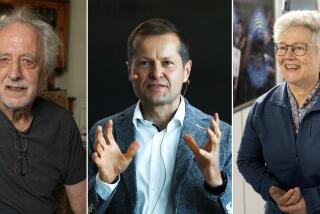Heinrich Rohrer dies at 79; a father of nanotechnology
- Share via
The electron microscope revolutionized biology in the 1930s by providing magnifications thousands of times higher than that of light microscopes, allowing scientists to discern the inner workings of cells for the first time.
But it was not nearly as helpful for materials scientists such as the ones constructing electronic circuits, who were more interested in surfaces. Exploring the details of those circuits required a completely new technology, the scanning tunneling microscope, which would provide images of individual atoms on surfaces.
Many scientists thought such a feat impossible. In 1979, however, physicists Heinrich Rohrer and Gerd Binnig of the IBM Research Laboratory in Zurich, Switzerland, patented such a device and forever changed the electronics industry. For their invention, they received the 1986 Nobel Prize in physics, an award they shared with physicist Ernst Ruska, who designed the first electron microscope.
FOR THE RECORD:
Heinrich Rohrer: In the May 24 LATExtra section, the obituary of Nobel Prize-winning physicist Heinrich Rohrer said that he and Gerd Binnig produced an image of the letters “IBM” in xenon atoms on a nickel crystal. In fact, Donald M. Eigler and Erhard Schweizer were the scientists responsible for that feat. Rohrer and Binnig patented the electron microscope used in the experiment. —
Rohrer and Binning were known as the fathers of nanotechnology — the construction and manipulation of extremely small objects — because their device could be used to move atoms around on a surface.
Rohrer died of natural causes May 16 at his home in Wollerau, Switzerland, according to IBM. He was 79.
“The invention of the scanning tunneling microscope was a seminal moment in the history of science and information technology,” John E. Kelly III, director of research at IBM, said in a statement. “This invention gave scientists the ability to image, measure and manipulate atoms for the first time, and opened new avenues for information technology that we are still pursuing today.”
The pair’s invention relies on a quantum-mechanical phenomenon known as tunneling, so called because the electrons pass through a supposedly impenetrable barrier, such as a vacuum. The phenomenon is the basis of scanning tunneling microscopy.
In tunneling, the tip of an electrically charged wire, for example, emits electrons in waves that roughly resemble the shape of a fountain. When two such devices are brought closely together, the overlapping waves partially merge and electrons flow through the gap, creating a small current.
Their device uses a stylus not unlike the needle of a record player. It is much smaller, however, converging to a point only one atom in diameter. In a high vacuum, the needle is brought close to the surface to be examined and a small electric charge applied, producing a current. The strength of the current depends on the distance between the point and the surface.
As the stylus is scanned back and forth across the surface — much like the electron beam of a cathode ray tube in a television — the current varies with the height of the surface. A computer moves the stylus up and down to keep the current constant. The record of those movements, converted into two dimensions, provides an image of the surface. The entire process relies on the current produced by tunneling.
The pair’s first experiment on a gold crystal produced an image of rows of precisely spaced atoms and broad terraces separated by steps one atom in height.
The movement of the stylus is very sensitive to any vibrations in the external environment. Rohrer had faced such difficulties before: In his graduate work on superconductors, he performed most of his experiments in the dead of night to minimize the city’s man-made vibrations. In their first experiments, the pair used powerful magnets set on a heavy stone table set on inflated rubber tires to shield the device.
Their first useful device had a heavy permanent magnet floating in a pool of superconducting lead. Within a couple of years, however, they had a device that, without the vacuum chamber, could fit in the palm of the hand. By 1987, they had reduced it to the size of a fingertip.
The stylus could also be used to push and pull individual atoms around on the surface. In 1990, Rohrer and Binnig produced the well-known image of the letters IBM formed from xenon atoms on a nickel crystal.
Heinrich Rohrer was born June 6, 1933, in the farming community of Buchs, Switzerland. His family moved to Zurich when he was 13, dramatically expanding his horizons. He had a lifelong interest in classical languages and natural sciences but studied physics at the Swiss Federal Institute of Technology in 1951 and received his doctorate in 1960.
After he married Rose-Marie Egger the next year, Rohrer accepted a fellowship at Rutgers University in New Jersey. For many years, the couple took extended camping trips across the U.S. with their two daughters.
In late 1963, he joined the newly formed IBM Research Laboratory. Except for a mid-1970s sabbatical at UC Santa Barbara, he stayed with IBM until 1997. Binnig still conducts research for IBM in Zurich.
Rohrer later accepted research posts in Japan and Spain, where he continued to focus on nanotechnology.
He is survived by his wife; daughters Doris and Ellen; and two grandchildren.






